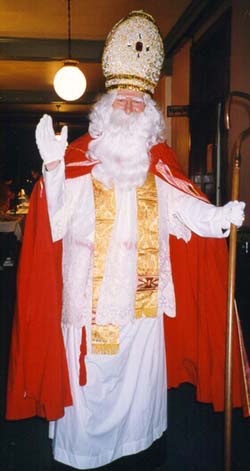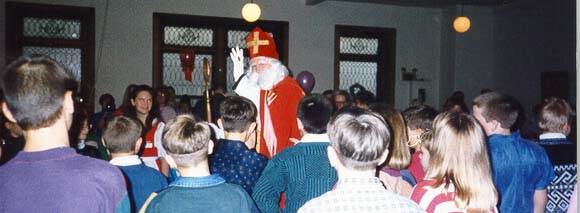THE LEGEND OF SANKT NIKOLAUS
In the German-speaking countries and Holland and Belgium as
well December 6th is the most distinctive children's festival of
the year. St. Nikolaus Eve is a time of festive stir, it is a time
of whispers and giggles, and of heavy steps on the stairs. Shops
are full of many-shaped biscuits, gilt gingerbreads, sometimes
representing the saint, of sugar images, toys and other little gifts.
 It is not easy to uncover the historic facts about Sankt Nikolaus,
the fourth century Greek bishop of Myra in Asia Minor (modern Turkey = ancient Greece, in part. see map1) and map2) who died on December 6th,
343. In Eastern Europe, Southern Italy and among the Greeks, he is revered
most of all as the patron saint of seafaring men.
It is not easy to uncover the historic facts about Sankt Nikolaus,
the fourth century Greek bishop of Myra in Asia Minor (modern Turkey = ancient Greece, in part. see map1) and map2) who died on December 6th,
343. In Eastern Europe, Southern Italy and among the Greeks, he is revered
most of all as the patron saint of seafaring men.
In many regions, the festivities originally attributed to the gift-
giving St. Nikolaus have been transfered to Christmas, yet in Western
and Southern Germany, in Austria, Switzerland, and the Low Countries,
December 6 remains a day of joy for children.
When evening comes, St. Nikolaus, a reverend grey-haired figure with
flowing beard, bishop's raiment, gold embroidered cope, mitre and pastoral
staff, will knock on doors and enquire about the behavior of the children.
The custom of examining the children, where they will deliver a verse,
sing, or otherwise show their skills, is still widespread in German-
speaking countries.
Nikolaus traditions vary as widely from region to region as his guise
and name. He appears as Ruhklas, Pelznickel, Klasbur, etc. He is afoot
or astride a white horse, a mule, or even a goat. More diverse than those
of the saintly Nikolaus are the many legends and traditions surrounding his often wild companions (Krampus, etc.). The pagan origin of all of these figures
His best known companion is Knecht Ruprecht (poem), "Knecht" meaning servant.
Historically, Ruprecht was a dark and sinister figure clad in a tattered
robe with a big sack on his back in which, legend has it, he will place
all naughty children.
St. Nikolaus also appears together with St. Peter, with an angel,
the Christchild (Christkindl or Christ Child). As the splendor of the candle-lit
Christmas tree and emphasis on the birth of Christ, began to shift
the function of the gift-giving St. Nikolaus, Knecht Ruprecht
became the servant and companion of the Christchild. In this role
Ruprecht became the patron saint of Christmas and was called
"Weihnachtsmann," (literally "Christmas Man") Father Christmas or Santa Claus.
As with the Christmas tree, St. Nikolaus was brought to this country
by German and Dutch immigrants. Oldtimers in Indiana still remember
Belshnickel, the Pelznickel (literally "Fur Niklaus; Pelz=pelt=fur). They helped
weave the legend of Santa Claus, the jolly good fellow created by
German-American cartoonist Thomas Nast.
Ruth Reichman
Max Kade German-American Center IUPUI.
Photos from the annual St. Nikolaus Fest, Das Deutsche Haus - Athenaeum in Indianapolis.

FURTHER RESOURCES
Customs, Teaching materials, St. Nick Day
- Look at some pictures: Thomas Nast and the image of Santa Claus
- What U.S. company turned Nast's Santa into our current version of Santa Claus?
- History of Santa with Thomas Nast images.
- The custom of gift-giving, shoes/stockings, chimneys
- Images of St. Nikolaus as an icon, his relics, his church - from my trip to S. Turkey.
-
- PAGE TWO OF HANDOUTS - St. Nikolaus' often wild companions (Krampus, etc.).
- Send a Nikolaus card - click the image, copy the email link and send a regular Gmail email
Absender = you, the sender
Empfänger = the recipient, who gets it
Vorschau – preview
Korrigieren – correct, edit
Abschicken - send
- Childhood memories / Kindheitserrinerungen. Adapted fromPetra's World. Side-by-side English and German
- My collection of AATG listmember Memories of Nikolausabend, various Santa figures, songs, teaching activities.
- Gabenbringer - who brings the gifts in which part of Germany?
.
- Lasst uns froh und munter sein with melody and other Nikolaus songs.
QUESTIONS FOR READING TEXT ABOVE
-
When is St. Nikolaus Day?
-
In what countries is it celebrated?
-
Who was the historical St. Nikolaus? Where and when did he live?
-
Describe how the St. Nikolaus figure looks.
-
Click on the link to his wild companions. What does Krampus look like?
-
Who is Knecht Ruprecht? What is his job or function?
-
Who is the Weihnachtsmann? What are some different names for the Santa figure?
-
How did this custom come to the US?
-
Click on several of the St. Nikolaus links, especially
the Images of St. Nikolaus, which are pictures from my visit to his
church in S. Turkey.
Return to German-American Christmas page.
 It is not easy to uncover the historic facts about Sankt Nikolaus,
the fourth century Greek bishop of Myra in Asia Minor (modern Turkey = ancient Greece, in part. see map1) and map2) who died on December 6th,
343. In Eastern Europe, Southern Italy and among the Greeks, he is revered
most of all as the patron saint of seafaring men.
It is not easy to uncover the historic facts about Sankt Nikolaus,
the fourth century Greek bishop of Myra in Asia Minor (modern Turkey = ancient Greece, in part. see map1) and map2) who died on December 6th,
343. In Eastern Europe, Southern Italy and among the Greeks, he is revered
most of all as the patron saint of seafaring men.
